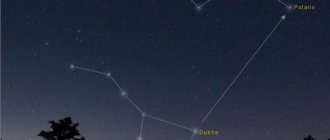Category: For the soul Published 08/19/2020 · Comments: · Reading time: 13 min
Greetings, dear guests of our research station called Domovenok-Art! Our team invites you to a fascinating walk through stellar and even intergalactic space with the most beautiful goal: to study the constellations of the Northern Hemisphere, how to find them in the night sky, which planets are visible from Earth, how to detect them overhead... What constellations are there and what are they called. We will tell you and show you. .
Find a comfortable position so that your neck does not become stiff. It will be interesting. And... they flew into the depths of space!
Brief travel program:
- what is a constellation?
- constellations of the Northern Hemisphere;
- what is next to the Big Dipper;
- more constellations of the Northern Hemisphere: how to find the constellation and galaxy of the Andromeda Nebula;
- the most mysterious constellation Orion;
- constellations Lyra, Cygnus and more;
- constellation Bootes, Northern Crown, Hercules;
What is a constellation
Constellations - translated from Latin, these are “groups of stars” into which the sky is conventionally divided for the convenience of orientation in various sciences (astronomy, astrology, etc.). Each group forms its own pattern. Each such pattern occupies its own area in the sky. At the same time, stars located in the same constellation are actually not connected with each other in any way, and in three-dimensional space they can occupy different positions relative to our planet, be either very far or closer, or be close or far from each other. But from Earth, in 2D, we see them as close objects that make up a certain pattern, a group.
And this simplification is convenient because the groups are small and easy to remember visually. And then navigate by them, or use them as a pointer when this or that cosmic phenomenon occurs.
Each constellation and its constituent stars have their own names. Many of them are of mythological origin: Cassiopeia, Ursa Major, Bootes, Andromeda and others. Some star groups were designated later, so they have more modern names, for example, Compass, Northern Crown, Southern Cross. Zodiacal constellations have been known since ancient times. There are 88 of them in total.
So observing the night sky is an activity known to man for a very long time. Scatterings of stars against the backdrop of cosmic darkness have always attracted attention. It's different at different times. But here’s the paradox: with such a long history, why do we know so little about them in our time? Why do many people simply do not know how to navigate the night sky and only know the Big Dipper and the North Star?
Yes, for obvious reasons, people in cities simply do not have such an opportunity - to regularly raise their heads up and see something there. With city lighting this is impossible. But there are trips outside the city. And in clear weather you can see so much! Let's look at what constellations of the northern hemisphere there are and what of them can be seen at night.
Online star map
Click on any object to receive expanded information and photos of its surroundings up to 1x1°. Add an online sky map to your bookmarks. An online star map will help with observations through a telescope and simply with orientation in the sky. Online star map - an interactive sky map shows the position of stars and nebulous objects that are visible to amateur telescopes at a given time over a given location.
To use an online star map, you need to specify the geographic coordinates of the observation location and the observation time. Only stars and planets with a brightness of up to approximately 6.5-7m are visible to the naked eye in the sky. To observe other objects you need a telescope
. The larger the diameter (aperture) of the telescope and the less illumination from the lights, the more objects will be available to you.
This online star map contains:
- the SKY2000 star catalog, supplemented with data from the SAO and XHIP catalogs. Total - 298457 stars.
- proper names of the main stars and their designations according to the HD, SAO, HIP, HR catalogs;
- information about stars contains (if possible): J2000 coordinates, proper motions, brightness V, Johnson B magnitude, Johnson BV color index, spectral type, luminosity (Suns), distance from the Sun in parsecs, number of exoplanets as of April 2012 , Fe/H, age, data on variability and fold;
- the position of the main planets of the solar system, the brightest comets and asteroids;
- galaxies, star clusters and nebulae from the Messier, Caldwell, Herschel 400 and NGC/IC catalogs with the ability to filter by type.
There are no objects from Messier in the Caldwell catalog, and Herschel 400 partially overlaps with the first two catalogs.
It is possible to search for nebulous objects on the map by their numbers in the NGC/IC and Messier catalogs. As you enter the number, the map is centered on the coordinates of the desired object. Enter only the object number as it is indicated in these catalogs: without the prefixes “NGC”, “IC” and “M”. For example: 1, 33, 7000, 4145A-1, 646-1, 4898-1, 235A, etc. Enter three objects from other catalogs: C_41, C_99 from Caldwell and the light nebula Sh2_155 in the NGC field as written here - with underlining and letters.
As an NGC/IC, we used its refined and somewhat expanded version RNGC/IC dated January 2, 2013 from the Dr. website. Wolfgang Steinicke. A total of 13958 objects.
About maximum magnitude: The faintest star in the SKY2000 catalog, which is used in the online sky map, has a brightness of 12.9m. If you are interested specifically in stars, keep in mind that after about 9-9.5m, gaps begin in the catalogue, and the further you go, the stronger they are (such a decline after a certain magnitude is a common occurrence for star catalogues). But, if stars are needed only to search for foggy objects in a telescope, then by introducing a limit of 12m you will get noticeably more stars for better orientation.
If you set the maximum 12m in the “stars are brighter” field and click “Update data”, then the initial download of the catalog (17MB) may take up to 20 seconds or more - depending on the speed of your Internet. By default, only stars up to V=6m (2.4MB) are loaded. You need to know the downloaded volume to select the map auto-update interval if you have limited Internet traffic.
To speed up the work, at low map magnifications (in the first 4 steps), NGC/IC objects fainter than 11.5m and faint stars are not shown. Zoom in on the desired part of the sky and they will appear.
When “turning off images from the Hubble telescope and others.” Only black and white photographs are shown, which more honestly show the image available in an amateur telescope.
Help, suggestions and comments are accepted by mail. Materials used from the sites: www.ngcicproject.org, archive.stsci.edu, heavens-above.com, NASA.gov, Dr. website. Wolfgang Steinicke The photographs used were declared free for distribution by their authors and transferred to the public use (based on data obtained by me in the places of their original placement, including according to Wikipedia, unless otherwise noted). If this is not the case, write me an e-mail.
Thanks: Andrey Oleshko from Kubinka for the original coordinates of the Milky Way. Eduard Vazhorov from Novocheboksarsk for the original coordinates of the outlines of the Foggy Objects.
Nikolay K., Russia
Constellations of the northern hemisphere
Just as the map of the Earth is divided into the eastern and western hemispheres, the map of the night sky can also be divided into two hemispheres - the northern and southern. And also the equatorial part. We are located in the Northern part, so we will consider it specifically.
The constellations of the northern hemisphere are those constellations that can be seen by residents on the northern side of the equator. And residents of the southern hemisphere will not be able to see them, because the Earth, on the scale of the universe, occupies a static position in relation to the other stars.
Some constellations of the northern hemisphere are always visible. These are those that are located close to the polar star (circumpolar constellations). And the polar star is a landmark pointing to the North Pole. These are Ursa Major and Ursa Minor, Andromeda, Cassiopeia, Dragon, Cepheus, Lynx, Hounds.
Other constellations either appear or go beyond the horizon at different times of the year. In summer, Perseus, the Northern Crown, Lyre, Coma Berenice, Bootes, and Hercules are clearly visible. In winter, you can see Orion, because bright Betelgeuse is one of the first to appear on the celestial canvas. However, it is also worth considering the breadth of residence. After all, the northern half of the Earth is also very large. And what a person living in the north and in the south sees may be different.
This concludes the theoretical part. Now we begin the practical part of our walk through the night sky.
List of sky constellations in alphabetical order
| Russian name | Latin name | Reduction | Area (square degrees) | Number of stars brighter than 6.0m |
| Andromeda | Andromeda | And | 722 | 100 |
| Twins | Gemini | Gem | 514 | 70 |
| Big Dipper | Ursa Major | UMa | 1280 | 125 |
| Big Dog | Canis Major | CMa | 380 | 80 |
| Scales | Libra | Lib | 538 | 50 |
| Aquarius | Aquarius | Aqr | 980 | 90 |
| Auriga | Auriga | Aur | 657 | 90 |
| Wolf | Lupus | Lup | 334 | 70 |
| Bootes | Boots | Boo | 907 | 90 |
| Veronica's hair | Coma Berenices | Com | 386 | 50 |
| Crow | Corvus | Crv | 184 | 15 |
| Hercules | Hercules | Her | 1225 | 140 |
| Hydra | Hydra | Hya | 1303 | 130 |
| Pigeon | Columba | Col | 270 | 40 |
| Hound Dogs | Canes Venatici | CVn | 465 | 30 |
| Virgo | Virgo | Vir | 1294 | 95 |
| Dolphin | Delphinus | Del | 189 | 30 |
| The Dragon | Draco | Dra | 1083 | 80 |
| Unicorn | Monoceros | Mon | 482 | 85 |
| Altar | Ara | Ara | 237 | 30 |
| Painter | Pictor | Pic | 247 | 30 |
| Giraffe | Camelopardalis | Cam | 757 | 50 |
| Crane | Grus | Gru | 366 | 30 |
| Hare | Lepus | Lep | 290 | 40 |
| Ophiuchus | Ophiuchus | Oph | 948 | 100 |
| Snake | Serpens | Ser | 637 | 60 |
| Golden Fish | Dorado | Dor | 179 | 20 |
| Indian | Indus | Ind | 294 | 20 |
| Cassiopeia | Cassiopeia | Cas | 598 | 90 |
| Keel | Carina | Car | 494 | 110 |
| Whale | Cetus | Set | 1231 | 100 |
| Capricorn | Capricornus | Cap | 414 | 50 |
| Compass | Pyxis | Pyx | 221 | 25 |
| Stern | Puppis | Pup | 673 | 140 |
| Swan | Cygnus | Cyg | 804 | 150 |
| a lion | Leo | Leo | 947 | 70 |
| Flying fish | Volans | Vol | 141 | 20 |
| Lyra | Lyra | Lyr | 286 | 45 |
| Chanterelle | Vulpecula | Vul | 268 | 45 |
| Ursa Minor | Ursa Minor | UMi | 256 | 20 |
| Small Horse | Equuleus | Equ | 72 | 10 |
| Little Leo | Leo Minor | LMi | 232 | 20 |
| Small Dog | Canis Minor | CMi | 183 | 20 |
| Microscope | Microscopium | Mic | 210 | 20 |
| Fly | Musca | Mus | 138 | 30 |
| Pump | Antlia | Ant | 239 | 20 |
| Square | Norma | Nor | 165 | 20 |
| Aries | Aries | Ari | 441 | 50 |
| Octant | Octans | Oct | 291 | 35 |
| Eagle | Aquila | Aql | 652 | 70 |
| Orion | Orion | Ori | 594 | 120 |
| Peacock | Pavo | Pav | 378 | 45 |
| Sail | Vela | Vel | 500 | 110 |
| Pegasus | Pegasus | Peg | 1121 | 100 |
| Perseus | Perseus | Per | 615 | 90 |
| Bake | Fornax | For | 398 | 35 |
| Bird of paradise | Apus | Aps | 206 | 20 |
| Cancer | Cancer | Cnc | 506 | 60 |
| Cutter | Caelum | Cae | 125 | 10 |
| Fish | Pisces | Psc | 889 | 75 |
| Lynx | Lynx | Lyn | 545 | 60 |
| Northern Crown | Corona Borealis | CrB | 179 | 20 |
| Sextant | Sextans | Sex | 314 | 25 |
| Net | Reticulum | Ret | 114 | 15 |
| Scorpion | Scorpius | Sco | 497 | 100 |
| Sculptor | Sculptor | Scl | 475 | 30 |
| Table Mountain | Mensa | Men | 153 | 15 |
| Arrow | Sagitta | Sge | 80 | 20 |
| Sagittarius | Sagittarius | Sgr | 867 | 115 |
| Telescope | Telescopium | Tel | 252 | 30 |
| Taurus | Taurus | Tau | 797 | 125 |
| Triangle | Triangulum | Tri | 132 | 15 |
| Toucan | Tucana | Tuc | 295 | 25 |
| Phoenix | Phoenix | Phe | 469 | 40 |
| Chameleon | Chamaeleon | Cha | 132 | 20 |
| Centaurus (Centaur) | Centaurus | Cen | 1060 | 150 |
| Cepheus | Cepheus | Cep | 588 | 60 |
| Compass | Circinus | Cir | 93 | 20 |
| Watch | Horologium | Hor | 249 | 20 |
| Bowl | Crater | Crt | 282 | 20 |
| Shield | Scutum | Sct | 109 | 20 |
| Eridanus | Eridanus | Eri | 1138 | 100 |
| South Hydra | Hydrus | Hyi | 243 | 20 |
| Southern Crown | Corona Australis | CrA | 128 | 25 |
| Southern Fish | Piscis Austrinus | PsA | 245 | 25 |
| South Cross | Crux | Cru | 68 | 30 |
| Southern Triangle | Triangulum Australe | TrA | 110 | 20 |
| Lizard | Lacerta | Lac | 201 | 35 |
Constellations - a snapshot from the planetarium program
Thanks to the observations of astronomers, it turned out that the location of stars gradually changes over time.
Accurate measurements of these changes require many hundreds and thousands of years. The night sky creates the appearance of a countless number of celestial bodies, randomly located in relation to each other, which often outline constellations in the sky. More than 3 thousand stars are visible in the visible part of the sky, and 6000 in the entire sky.
What other constellations are visible in the night sky in the northern hemisphere?
We looked at the circumpolar constellations, which are visible at any time of the year. But this is not all the interesting things that can be found in the Northern Hemisphere sky at night. So let's move on and look at a few more beautiful groups of stars.
How to find Andromeda constellation and galaxy
Despite the fact that the Andromeda Nebula is the closest galaxy to our Milky Way, and that it is rapidly moving towards us, it looks like a small star. One of the stars in the constellation Andromeda. Finding the constellation Andromeda in the night sky is not difficult, although the galaxy itself is barely visible.
Interesting! The Andromeda Nebula is the only galaxy that can be observed at polar and temperate latitudes with the naked eye. Can you imagine the size of space?
Find the constellation Cassiopeia and the North Star. Draw a straight line from the North Star through the star Shedar in Cassiopeia (see picture). And if you move further away from Shedar, approximately equal to half the distance between these stars, you will see a small cloud. This is the Andromeda galaxy. And nearby there are three stars - part of the Andromeda constellation. Better look at the drawing.
Constellation Perseus in the night sky
Perseus is adjacent to Cassiopeia. It’s very easy to find it if you look a little “below” from the letter M and Andromeda. This is a fairly large constellation, very clearly visible in the summer, in August.
Mysterious constellation Orion
If we move even “lower” across the night sky, somewhere between Perseus and the bright star Capella from the constellation Auriga (this star is very clearly visible in the northeast in summer), we will meet the most mysterious star hero - the constellation Orion. This is an equatorial constellation. This means that it can be seen both in the northern and southern hemispheres. But everything has its time... And the time of the appearance of the mythical hunter is also determined.
The constellation Orion is best seen in winter. Its brightest star, the red supergiant Betelgeuse, is one of the first to appear in the night sky. To see Orion in summer, you have to wait until the middle of the night. For example, in August, around 3-4 o'clock in the morning, it is visible in the southeastern part of the sky.
And the constellation itself is easy to find by its characteristic asterism (an easily distinguishable group of stars) - Orion’s Belt, which represents three bright stars in one line. And if we look a little wider, we will see a recognizable figure a la an hourglass from the stars Betelgeuse, Bellatrix, Saif and Rigel.
Star maps
A star map or atlas is a map of the night sky that includes the most popular stars and constellations. Astronomers prefer to divide them into grids to simplify practical use. They are used to identify and locate constellations and a variety of astronomical objects such as stars, nebulae and galaxies.
Maps have been created and used by humans to navigate the world since the dawn of astronomy. It is important to know that such a map differs from an astronomical catalog in many ways. The latter is a list or table of astronomical objects for a specific purpose, rather than an illustrative example. Instruments that use the star chart include the astrolabe and the planisphere.
Movement of celestial objects along the constellations
Due to the rotation of the Earth, stars move. Because the Earth rotates from west to east, they appear to rise in the east, moving through the south to stop in the west. Sometimes the Sun may seem to move through them, making one full circle every 365 days.
The earth is tilted 23.5 degrees from vertical. This fact not only gives us the concept of seasons, but also changes the perception of the sky. This explains that we see different constellations in each season. But there are also those that we see all year round. They are called circumpolar. All these clusters of stars surround the North Star, and since we live in the Northern Hemisphere, we have the opportunity to look at them all year round. These constellations are Ursa Major, Cassiopeia, Ursa Minor and Cygnus.
Zodiac constellations
Those constellations through which the path of the Moon and the Sun passes are called zodiacal. In one season, the Sun passes through three zodiac constellations:
- Spring – Pisces, Capricorn, Virgo.
- Summer – Libra, Sagittarius, Scorpio.
- Autumn – Leo, Aquarius, Taurus.
- Winter – Gemini, Cancer, Aries.
The constellations in which the Sun is located at the moment become visible six months later, when they appear in the evening. In sunlight they are simply not visible, but six months later they appear on the side opposite to the Sun and are visible at night.
Zodiac constellations in astrology are attributed special properties, which, of course, actually do not exist. Planets also move only along the zodiacal constellations, and this becomes the basis of various horoscopes.











